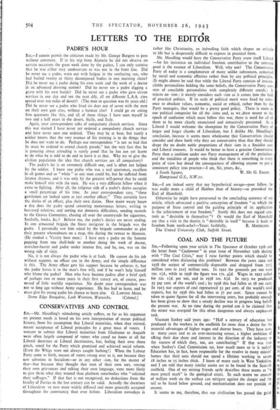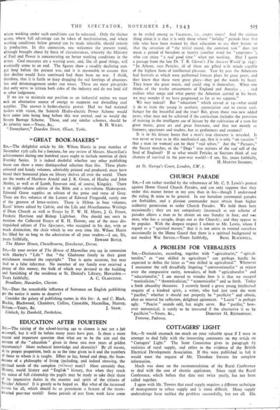COAL AND THE FUTURE Stn,—Following upon your article in The
Spectator of October r5th and the letter from " Coalowner " in your issue of November 12th dealing with " The Coal Crisis," may I raise further points which should be considered when disZussing this problem? Between the years 1922 and 1938 the output of commercially disposable coal dropped from 2271 million tons to 210f million tons. In 1922 the proceeds per ton were 19s. rid., while in 1938 the figure was 17s. aid. Wages in 1922 called for I2S. rid. per ton, and in 5938 Dos. 6,4d. In 1913 we produced 23 per cent. of the world's coal ; by 1938 this had fallen to r8 per cent. In 1913 our exports of coal represented 55 per cent. of the world's total exports, but by 1938 this had fallen to 37 per cent. Space cannot be taken to quote figures for all the intervening years, but probably enougth has been given to show that a steady decline was in progress long befott the present war. At no time during the period can it be claimed that the miner was overpaid for this often dangerous and always unpleasant task.
Viscount Sankey said years ago: "Half a century of education has produced in the workers in the coalfields far more than a desire for the material advantages of higher wages and shorter hours. They have now, in many cases and to an ever-increasing extent, a higher ambition of taking their due share and interest in the direction of the industry to the success of which they, too, are contributing." If that was true when Sankey's Coal Commission sat, how much more so is it today? Education has, in fact, been responsible for the resolve in many miners' homes that their sons should not spend a lifetime working in seams 18 inches to 15 inches thick. I know of many such in West Yorkshire, and I am told that many similar seams are to be found in the Scottish coalfield. One of my mining friends aptly describes these seams as "a mere pencil mark" in the geological strata. In such seams no amount of welfare work on the surface can mitigate against the danger and the toil to be faced below ground, and mechanisation does not provide an answer.
It seems to me, therefore, that our civilisation has passed the point where working under such conditions can be tolerated. Only the thicker seams, where full advantage can be taken of mechanisation, and where working conditions below ground can be made tolerable, should remain In production. In this connexion, one welcomes the present trend, although brought about by force of circumstances, whereby the Ministry of Fuel and Power is concentrating on better working conditions in the mines. Coal measures are a wasting asset, and, like all good things, will eventually come to an end. The figures show a steadily declining out- put long before the present war, and it is reasonable to assume that that decline would have continued had there been no war. I think, therefore, that it is futile to keep dragging the red herrings of absentee- Ism and. mismanagement under our noses. These are mere pin-pricks that only serve to irritate both sides of the industry and do not lend aid to sober judgement.
If we are to maintain our position as an industrial nation we must seek an alternative source of energy to augment our dwindling coal supplies. The answer is hydro-electric power. Had we had national leaders with vision, the Scottish Hydro-electric Power Scheme would have come into being long before this war started, and so would the Severn Barrage Scheme. These, and any similar schemes, should be



























 Previous page
Previous page